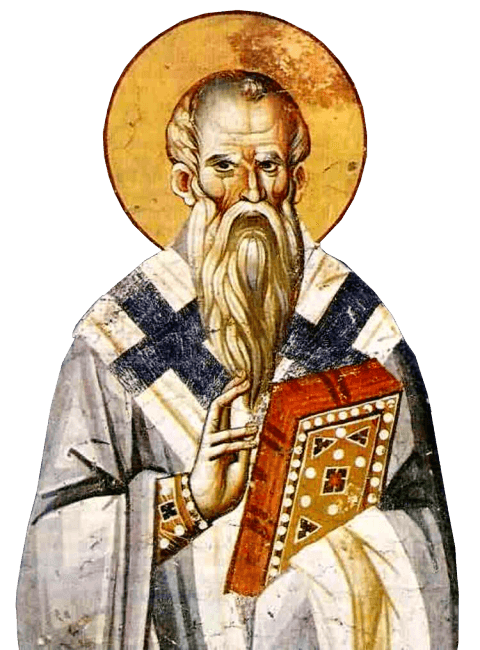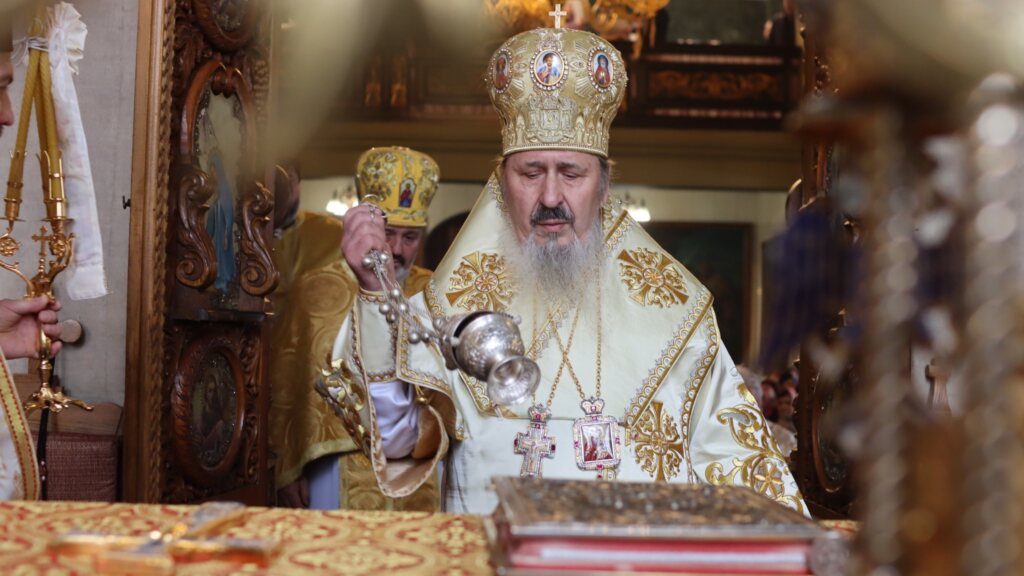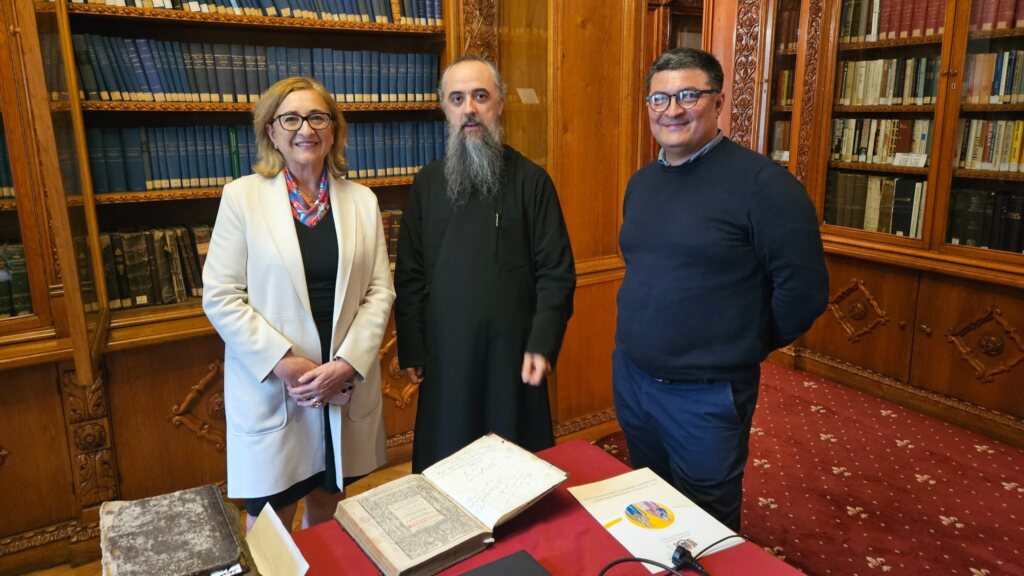Hieromartyr Clement, Pope of Rome
He was born at Rome into a rich and illustrious family. Separated from his parents from childhood by force of circumstances, Clement was raised by strangers. Living in Rome, the youth received a fine education, he was surrounded by luxury, and had access to the imperial court. But these comforts brought him no joy, and pagan wisdom failed to attract him. He began to ponder the meaning of life.
When the news of Christ and His teaching began to reach the capital, Saint Clement left his home and estate and went to the lands where the Apostles were preaching. At Alexandria Saint Clement met the holy Apostle Barnabas, listening to his words with deep attention, and perceiving the power and truth of the Word of God.
Arriving in Palestine, Saint Clement was baptized by the holy Apostle Peter and became his zealous disciple and constant companion, sharing his toil and sufferings with him. Shortly before his own sufferings and death, Saint Peter consecrated Saint Clement as Bishop of Rome. After the death of the Apostle Peter, Saint Linus (67-79) was the next Bishop of Rome, succeeded by Saint Anacletus (79-91), and then Saint Clement (92-101).
The virtuous life, charitable works and prayerful activity of Saint Clement converted many to Christ. He once baptized 424 people on the day of Pascha. Among the baptized were people of all social classes: slaves, officials, and even members of the imperial family.
The pagans, seeing the success of his apostolic preaching, denounced Saint Clement to the emperor Trajan (98-117), accusing the saint of insulting the pagan gods. The emperor banished Saint Clement from the capital, sending him to the Crimea, to work at a stone quarry near the city of Cherson. Many of the saint’s disciples followed after him voluntarily, preferring to go into exile rather than live without their spiritual Father.
When he arrived at the place of exile, Saint Clement found many Christian believers there, sentenced to labor under harsh conditions amidst a scarcity of water. He prayed together with the condemned, and the Lord appeared to him in the form of a lamb and revealed the location of a spring, from which gushed forth a veritable river of water.
This miracle attracted a multitude of people to Saint Clement. Hearing the zealous preacher, hundreds of pagans were converted to Christ. Each day 500 or more men were baptized. And there in the stone quarry, a church was built, in which he served as priest.
The apostolic activity of the saint aroused the wrath of the emperor Trajan, and he ordered that Saint Clement be drowned. They threw the martyr into the sea with an anchor tied to his neck. This occurred in the year 101.
The saint’s faithful disciples Cornelius and Fibius asked the people to pray that the Lord would permit them to see the martyr’s body. The sea drew back a distance of three miles from the shore and the people walked out on the seabed until they found a marble cave shaped like a church. There they found the incorrupt body of their archpastor in this “Angelic Church” formed by God. After this, each year on the anniversary of Saint Clement’s martyric death the sea receded, and for seven days Christians were able to venerate his holy relics.
During the reign of the Byzantine Emperor Nicephorus (802-811), by divine providence, the sea failed to withdraw, and the relics of Saint Clement became inaccessible for fifty years. In the time of the emperor Michael and his mother Theodora (855-867), Saints Cyril and Methodius visited Cherson. When they learned of the concealed relics of Saint Clement, they asked Bishop George of Cherson to pray that the Lord would show them the relics of the hieromartyr.
Saints Cyril and Methodius walked along the shore in procession with the clergy who came with them from Constantinople. Through the fervent prayers of everyone gathered there, the holy relics of Saint Clement miraculously appeared on the surface of the sea at midnight.
They solemnly took them to the Church of the Holy Apostles at Constantinople. A portion of the relics were then brought to Rome by Saints Cyril and Methodius, but a large portion of the relics was later brought to Kiev by the holy Prince Vladimir (July 15) and placed in the Desyatin-Tithe church, together with the relics of Saint Fibius, where a chapel dedicated to Saint Clement had been built.
The hieromartyr Clement is widely venerated in Russia. From ancient times, many churches have been dedicated to him.
Saint Clement, who belongs to the Apostolic Fathers, has left to us a spiritual legacy (two Epistles to the Corinthians) the first written examples of Christian teaching after the writings of the holy Apostles.
Holy Hieromartyr Peter, Archbishop of Alexandria
He was born and raised at Alexandria. He was a highly educated man, and was head of the school of Alexandria. In the year 300 he became the archpastor of the Alexandrian Church, succeeding his teacher and spiritual guide, the holy Bishop Theonas.
Forced into exile from the city during the anti-Christian persecutions under the emperors Diocletian and Maximian, Saint Peter traveled through many lands, encouraging his flock by letter. Again returned to his city, in order to guide the Alexandrian Church personally during this dangerous period.
The saint secretly visited Christians locked up in prison, encouraging them to be steadfast in faith, assisting the widows and orphans, preaching the Word of God, constantly praying and officiating at the divine services. And the Lord kept him safe from the hands of the persecutors.
During this time of unrest the iniquitous heretic Arius, who denied the divinity of Jesus Christ, sowed the tares of his impious teaching. When Arius refused to be corrected and submit to the truth, Saint Peter anathematized the heretic and excommunicated him from the Church.
Arius then sent two of Saint Peter’s priests to beg the saint to lift the excommunication from him, pretending that he had repented and given up his false teachings. This was not true, for Arius hoped to succeed Saint Peter as Archbishop of Alexandria. Saint Peter, under the guidance of the Holy Spirit, saw through the wickedness and deceit of Arius, and so he instructed his flock not to believe Arius nor to accept him into communion.
Under the wise nurturing of Saint Peter the Church of Alexandria strengthened and grew in spite of the persecutions. But finally, on orders from the emperor Maximian (305-311), the saint was arrested and sentenced to death. A multitude of people gathered at the entrance of the prison, expressing their outrage.
Wanting to avoid bloodshed and a riot by the people, the saint sent a message to the authorities, in which he suggested that they make an opening in the back wall of the prison, so that he might be taken away secretly to execution.
In the dark of the night Saint Peter went with the executioners, who took him beyond the city walls and beheaded him at the same spot where formerly Saint Mark had been executed. That night a certain pious virgin heard a Voice from heaven saying, “Peter was first among the Apostles; Peter is the last of the Alexandrian Martyrs.”
This took place in the year 311. In the morning, when people learned of the death of their bishop, a crowd gathered at the place of execution. They took up the body and head of the martyr and went to the church, dressing him in his bishop’s vestments, they sat him in his throne at the high place in the altar.
During his life Saint Peter never sat on it, but sat on a footstool instead. The saint once explained that whenever he approached his throne he beheld a heavenly light shining on it, and he sensed the presence of a divine power. Therefore, he didn’t dare to sit there.
The Lord Jesus Christ once appeared to Saint Peter as a twelve-year-old child wearing a robe that was torn from top to bottom. Saint Peter asked the Savior who had torn his garment, and He replied, “That madman Arius has torn it by dividing the people whom I have redeemed by My blood. Do not receive him into Communion with the Church, for he has worked evil against Me and My flock.”
Saint Peter, a great champion of Orthodoxy, is known also as a profound theologian. Passages from his book, “On the Divinity (of Jesus Christ)”, were consulted at the Councils of Ephesus and Chalcedon. Of all his works, the most widely known and highly esteemed by the Church are his “Penitential Canons”.
Troparion of the saints — Tone 4
O God of our Fathers, / always act with kindness towards us; / take not Your mercy from us, / but guide our lives in peace / through the prayers of the hierarchs Clement and Peter.

Tr by oca.org






